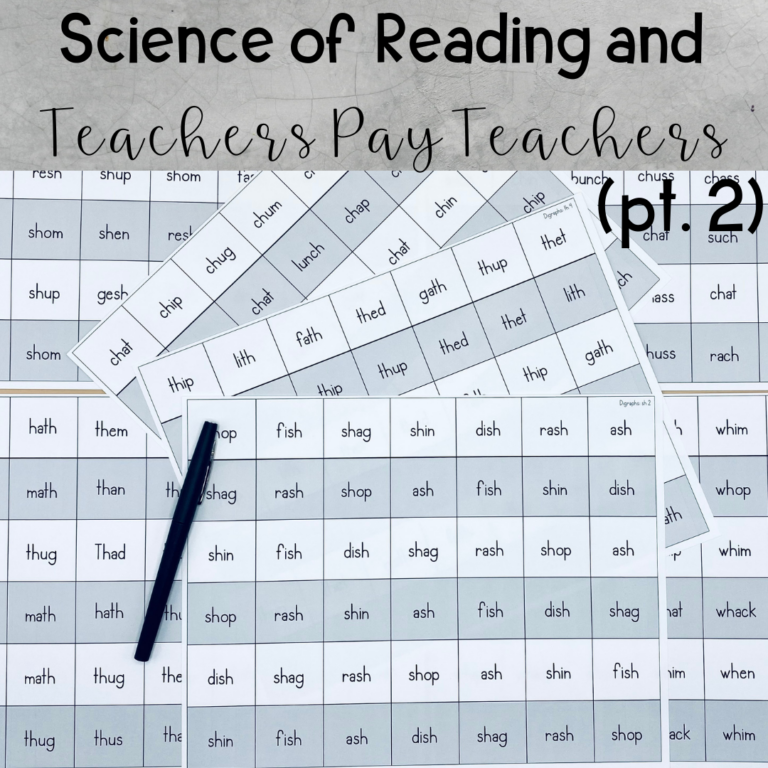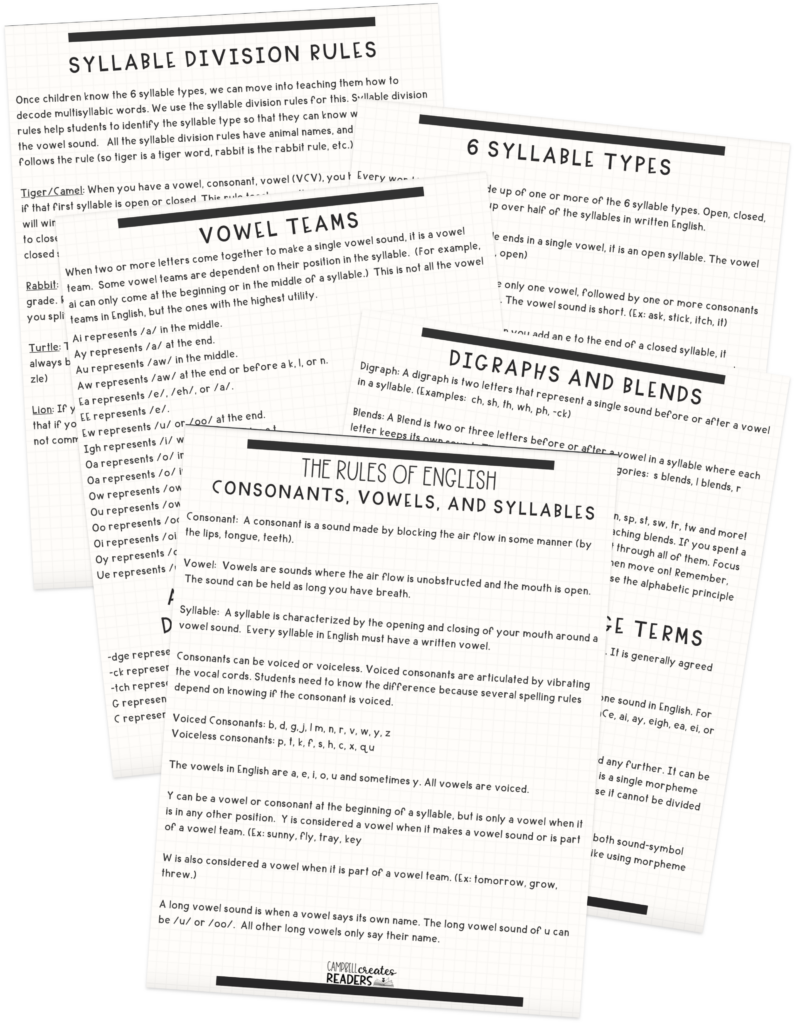
Share This:
You’ve administered the universal screeners and determined the children who need help. After carefully determining a starting point for instruction, you’ve delivered quality intervention with consistency.
But now time has passed, and your progress monitoring data is showing you that some kids just aren’t making progress. So what do we do?
I talk a lot about intervention and structured literacy. But I’ve never really discussed what to do when you’ve provided intervention and your students STILL aren’t making the progress needed to close the gap. So, let’s talk about the steps we can take when the intervention isn’t having the impact we want.
We cannot change that Mary’s mom never checks her folder. We can do nothing about the fact that Tommy’s dad is in jail. And we don’t know if Sam and his family will move for the 5th time in two years.
We can sympathize for what our children must deal with at home. And hopefully your school has resources to help with difficult times at home. What we can’t do, however, is allow factors outside of our control to be an excuse as to why our children are not making progress
When we use external factors as an excuse as to why children are not progressing, the responsibility is no longer on ourselves. And at the end of the day, the teachers and school are responsible for any progress the child is or is not making.

There have been times where I’ve been in meetings and it was expressly stated that we would not talk about things we cannot change. Time is precious, and too often meetings spiral into all the reasons we can’t do anything, instead of focusing on the things we can do to make intervention more effective for our students.
Time is the one thing that we will never have enough of, and yet it is also the thing so many of our children desperately need. Not just time to “catch up,” but time from qualified individuals who are there to ensure that all students are successful.
If you have a student who is not progressing as quickly as you’d hoped, one factor to consider is time. Are you meeting with this child daily, or only once or twice a week? Are these groups lasting 15 minutes or 30 minutes?
I typically take children for 30 minutes four times a week. However, when there are students who are not making progress with that amount of time, one thing I can do is increase the amount of time I spend with them. You might have to get creative, but there are almost always some stolen minutes we can reclaim. These creative ways of getting time work best with smaller groups or 1:1.

There may be times where the intervention itself needs to change. Perhaps you started with a group whose intervention focus was basic phonics instruction. As time progresses, however, you realize that it isn’t single-syllable words where the students need their focus. Instead, they actually need to work on decoding multisyllabic words. You would change the focus of the entire group to more accurately reflect their current needs.
There may be other times where the skill focus is correct, but the children aren’t making progress in the way we’ve presented it. Perhaps you have children with focus issues and they need their intervention to be peppered with lots of movement and short tasks. We know that all children don’t learn to read in different ways, but that doesn’t mean that all children are engaged in the same way. We can alter our instructional routines in order to be more reflective of what our students need.
I had a girl once where we played a game every single day. It was a phonics game, but for this student, she needed to have the break that a game can provide. This summer, I tutored a student and created a visual schedule of what we were going to do that day. I showed him all the tasks we had to do at the beginning of the lesson, but he got to organize the cards and complete the tasks in the order he wanted.

There are infinite ways to change the intervention, but it can be difficult to do the first couple times. When we change the intervention, it can feel like we didn’t “get it right” for these children or that we messed up. But take comfort in knowing that you made the best decisions at that time with what you knew, and when we makes these changes, we are simply continuing to make the most appropriate choice with the information we have. There is no need for shame or remorse.
After you’ve administered universal screeners, you’ll place students in groups. But that doesn’t mean that students stay in those groups forever. I always hear people speak about “fluid grouping,” but I think that is a bit unwise as well. Let me explain.
I agree that your groups shouldn’t always stay the same. We don’t want to put kids in a group for struggling readers and then they stay there forever. I’m a firm believer that reading intervention doesn’t need to be a life sentence. BUT, we also need to acknowledge that it takes TIME to intervene, and we shouldn’t move groups based off one or two data points. We need enough time to allow the intervention to work before we begin making changes.

Once we have given the intervention enough time to work, then we can start making data-based decisions about the intervention moving forward. If Tammy has been excelling on every progress monitoring point, perhaps it is time to move her to another group with a more accelerated focus. If Sam’s peers are progressing faster than him, we may need to move Sam to a different group or begin taking him 1:1 in addition to his current groups.
Assigning a student to an intervention should never be a life sentence, but intervention needs enough time to move the needle for our students. We don’t want to “pull the rug” on the intervention before it’s been given a real chance to work.
When someone reaches out to me about a child not making progress in intervention, the first question I always ask is: “How much reading and writing practice do they receive daily?” Intervention may very well be the only point in a child’s day where they are able to read texts themselves that are instructionally appropriate for them. So we must ensure that our students get enough practice with us in a small group to reach automaticity.
Authentic reading and writing in intervention is not worksheets. It is not crossword puzzles or word searches. None of those things are inherently bad (it’s all in how you use them), but none of those things provide the authentic reading and writing experiences that children in intervention need to catch up.
Authentic reading is reading texts that are instructionally appropriate (decodables for phonics groups, themed texts for comprehension groups). Authentic writing should look like dictation at the word and sentence level, as well as writing about texts they’ve been reading (for comprehension groups).

Students in intervention need a lot of time to practice. And we want to practice in authentic ways. Many students will orthographically map a phonics pattern with between 1-4 exposures. For our struggling students, it may take dozens or even hundreds of exposures before a pattern sticks. We must give them enough time in authentic reading and writing experiences so that the orthographic features become automatic to them. We cannot overemphasize the role of automaticity in becoming proficient.
Collaboration is critical, but I’m also a realist. If you have 8 groups, it would be impossible for you to meet with each teacher about each child each week. And I’m not here to live in the realm of fantasy: we need to talk about what we can ACTUALLY do to tighten up collaboration.
When you are working with a student in intervention, you should follow the same phonics sequence as the classroom teacher as much as possible. While you will not be on the same skills as the class, you should still target the skills in the same order as the teacher. Additionally, we should use the same language as the classroom teacher. If the teacher calls them r-controlled vowels, call them r-controlled vowels. If the teacher asks students to “throw” sounds instead of “tapping” sounds, it would benefit our children to use the same language. I let the teacher choose the language, and I try to lean into it as much as possible to provide clarity for our intervention students.
One way to increase collaboration is to have access to the classroom teacher’s lesson plans. This way, you can see what is coming up in class. While you may not be teaching the same skills, it allows you both to understand what the child is facing in class and where they need to eventually go. It is also helpful for comprehension groups to see the science and social studies topics your students are learning. You can help build background knowledge by using texts around some of the same topics.

Collaboration may also look like meeting with teachers to talk about all students regularly throughout the school year. At my former school, we had data meetings every other week during a grade-level’s planning period. During this time, all teachers in a grade level, administration, interventionists, and paraprofessionals would meet to talk about the data we had. During these meetings, we would note which kids were making progress and which weren’t. We could also brainstorm small tweaks to be made in intervention or in the classroom to help students become more successful. We had a Google Drive all teachers could all access with relevant data about the students.
We have a lot of research about the importance of early intervention, including the Hart and Risley study (1995) and the National Reading Panel (2000). We know that intervening early is the easiest way to make a difference. It makes sense that you would want to intervene before the gap gets any wider. If a child is struggling in kindergarten, it will not magically go away by third grade. A child who doesn’t know letter sounds can, without intervention, become a child who is struggling in multiple aspects of school. It is much more difficult to intervene the older children get.
Notice I said it was more difficult, but I didn’t say impossible. We are not giving up on these students, but it will likely be more challenging the older the students get. You will not see progress in 4th grade that you would see in 1st grade. With older kids, it takes more time to move the needle. But the needle can be moved when we use the data to provide targeted intervention. And when we don’t give up.
I include this for a few reasons. First, I don’t believe it is pointless to intervene with older children. I just think we would have a lot less older students needing it if we spent the majority of our resources on early intervention. I also don’t want you to feel disheartened that your fourth grade progress monitoring data doesn’t look as good as your first grade data. It WILL take longer for those children to find progress. Before making huge decisions, it is important ask yourself if they have been given enough time for the intervention to work.
It is not easy to look at your own teaching and ask “What can I do differently for this child?” Teaching is such a personal job, it is such a craft, that having to look at what we are doing can feel like we have failed. But reflection is a natural part of the process. The more we are able to openly reflect on what is and isn’t working, the better job we will be able to do for our students. I hope some of these ideas have struck home with you. And if you are an interventionist, thank you for all you do every single day to ensure these struggling readers close the gap and meet their goals.
Share This:

Savannah Campbell is a K-5 reading specialist. She has taught her entire 12-year teaching career at the school she went to as a child. She holds two master’s degrees in education from the College of William and Mary. Savannah is both Orton-Gillingham and LETRS trained. Her greatest hope in life is to allow all children to live the life they want by helping them to become literate individuals.

Savannah Campbell is a K-5 reading specialist. She has taught her entire 12-year teaching career at the school she went to as a child. She holds two master’s degrees in education from the College of William and Mary. Savannah is both Orton-Gillingham and LETRS trained. Her greatest hope in life is to allow all children to live the life they want by helping them to become literate individuals.
Feeling overwhelmed with all the terminology out there? Want to know the key terms all teachers need to teach phonics? In this FREE Rules of English cheat sheet, you get a 5 page pdf that takes you through the most important terms for understanding English—you’ll learn about digraphs, blends, syllable types, syllable divisions, and move. Grab today and take the stress out of your phonics prep!
